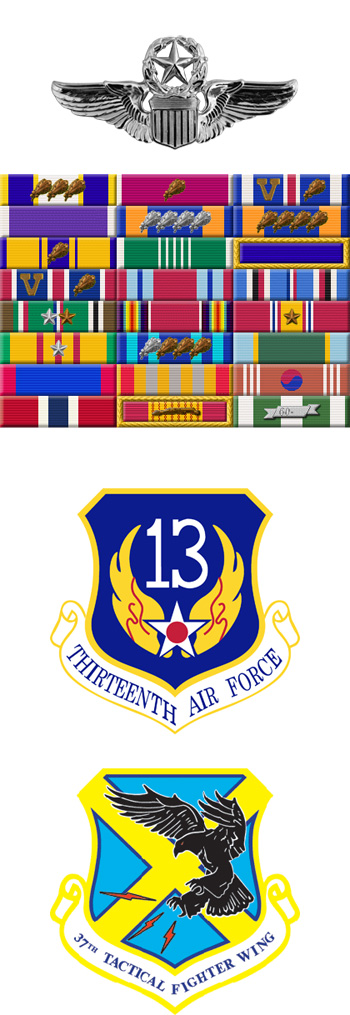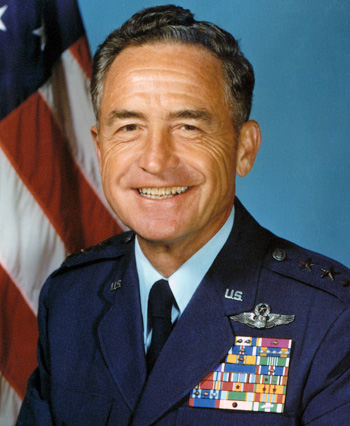
|
LeRoy J. Manor |
 |
|||
| Rank, Service | ||||
Lieutenant General O-9, U.S. Air Force |
||||
| Veteran of: | ||||
|
||||
| Tribute: | ||||
Roy Manor was born on February 21, 1921, in Morrisonville, New York. He enlisted in the U.S. Army Reserve on June 8, 1942, and entered the Aviation Cadet Program of the U.S. Army Air Forces on November 19, 1942. Manor was commissioned a 2d Lt and awarded his pilot wings at Spence Field, Georgia, on August 30, 1943, and after completing P-47 Thunderbolt training, he was assigned to the 365th Fighter Squadron of the 358th Fighter Group in Europe from December 1943 to September 1945. His next assignment was with the Air Proving Grounds at Eglin Field, Florida, followed by an Air Force Institute of Technology assignment to complete his bachelor's degree at New York University. Capt Manor completed Instructor Pilot School in May 1947, and then served with the Tactical Air School at Tyndall AFB, Florida, the Squadron Officer School at Maxwell AFB, Alabama, and at the Air-Ground Operations School in Southern Pines, North Carolina. He was an operations staff officer with the 6th Allied Tactical Air Force at Izmir, Turkey, from September 1953 to August 1955, and then commanded the 2242nd Air Reserve Flying Center at Selfridge AFB, Michigan, from August 1955 to July 1958. Col Manor attended Armed Forces Staff College from July 1958 to January 1959, and then commanded the 481st Tactical Fighter Squadron of the 27th Tactical Fighter Wing at Cannon AFB, New Mexico, from January 1959 to July 1960. He served as Chief of the Tactical Evaluation Division with Headquarters U.S. Air Forces in Europe at Lindsey AS, West Germany, from July 1960 to June 1963, and then attended the Industrial College of the Armed Forces from August 1963 to May 1964. Col Manor next served with Headquarters U.S. Air Force in the Pentagon from June 1964 to March 1968, followed by service as commander of the 37th Tactical Fighter Wing at Phu Cat AB in the Republic of Vietnam from May 1968 to May 1969. During this time Col Manor flew 275 combat missions in the F-100 Super Sabre. His next assignment was as commander of the 835th Air Division at McConnell AFB, Kansas, from June 1969 to February 1970, followed by service as commander of the U.S. Air Force Special Operations Force at Eglin AFB, Florida, from February 1970 to February 1971. During this time, Gen Manor also commanded Operation Ivory Coast, the Son Tay Raid to rescue American Prisoners of War at the Son Tay POW Camp in North Vietnam, on November 21, 1970. He was special assistant for counterinsurgency and special activities on the staff of the Joint Chiefs of Staff at the Pentagon from February 1971 to February 1973, and then served as Vice Commander and then Commander of 13th Air Force at Clark AB in the Philippines from February 1973 to October 1976. Gen Manor's final assignment was as Chief of Staff of U.S. Pacific Command at Camp Smith, Hawaii, where he served from October 1976 until his retirement from the Air Force on June 1, 1978. Gen Manor wears Command Pilot Wings and accumulated over 6,500 flying hours during his Air Force Career, as well as flying 347 combat missions in two wars. |
||||
|
||||

